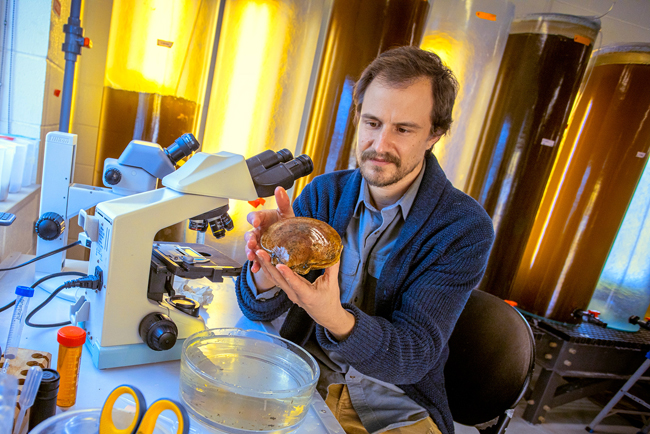
Stephen Tomasetti at the Marine Sciences Center at Stony Brook Southampton. Credit: John Griffin
NOTE: Funding for this research study includes support from New York Sea Grant: Ocean acidification in the New York Bight: Associations with eutrophication processes and implications for shellfish populations (R/CMB-46)
If you don't see the player above, it's because you're using a
non-Flash device (eg, iPhone or iPad). You can download the mp3 file by clicking here (mp3). It may take a few minutes to download, so please be patient.
— Filed by J.D. Allen for WSHU FM
Stony Brook, NY, January 20, 2023 - Once one of the largest fisheries on the East Coast, Peconic Bay scallops have faced near complete die-offs on Long Island since 2019.
A study by Stony Brook University shows this could be a cautionary tale for New England.
Christopher Gobler, a co-author and endowed chair of coastal ecology and conservation in the School of Marine and Atmospheric Sciences, used satellite thermal imaging and recorded scallop heartbeats to measure the stress less oxygen and warming waters have on shellfish populations.
Data shows over the past two decades, the Peconic Bay estuary — and the entire Northeast — are warming at rates during summer that far exceed global average; Gobler said, “about threefold higher.”
“We found that when placed in areas that were experiencing heatwaves, all the scallops died, whereas the ones that were in cooler temperatures, they survived,” he said.
The focus of the study was on extreme summer temperatures, becoming more frequent due to climate change, which have made bay scallops more vulnerable to environmental stress. The heartbeat response of bay scallops were measured using optical infrared sensors, or “scallop fitbits.”
According to satellite imagery and long-term environmental records, the temperature of New England waters has increased faster than any other place in the U.S., and will soon approach Long Island’s current conditions.
The only commercial U.S. fishery of the same species of northern bay scallop, which has already vanished in waters south of New York, is found in Massachusetts. Gobler noted his research, published in Global Change Biology, suggests the scallops may go the way of the lobster.
“The Long Island lobster: Well, look what happened there,” Gobler said. “It got too warm in Long Island Sound, and that population crashed. But then it thrived further north, in Maine. But now people say that maybe it's even getting too warm up there.”
“In climate change, there are winners and losers. And so that can be said with regards to organisms, but actually can be said with regards to things, like fisheries and states,” he continued. “New York became a climate change loser, whereas places in the north are hanging in there. But, if the trends continue, then we would expect that those organisms may continue to move north.”
Northern bay scallops can be found as far north as Canada.
The authors warn that while mobile fish can respond by moving to waters with more tolerable temperatures, shellfish, which rely on dispersing spawn to migrate, may be forced to cope with extreme heat. Marine biologist Stephen Tomasetti, a co-author, said this could result in more mass mortality events, impacting commercial economies.
“Commercial shellfisheries are a vital part of our blue economy, and shellfish habitats are changing rapidly,” Tomasetti said in a statement. He points to other examples of “heat-induced mass mortality” on the East Coast, including lobsters in Long Island Sound and blue mussels in Delaware.
Gobler recognized other factors impacting the scallops, including new predators and parasites that have become more prevalent because of warming waters, and the oversaturation of nitrogen in the water, due to wastewater pollution and stormwater runoff, which creates algal blooms that zap oxygen from the water, suffocating scallops.
This reduction of oxygen also creates water conditions that are too acidic for the scallops. Warmer water also holds less oxygen. “It all, sort of, points to the idea that these scallops are, you know, more commonly encountering temperatures that are not permissive for their survival,” he said.
More Info: New York Sea Grant
New York Sea Grant (NYSG), a cooperative program of Cornell University
and the State University of New York (SUNY), is one of 34 university-based
programs under the National Oceanic and Atmospheric Administration’s
National Sea Grant College Program.
Since 1971, NYSG has represented a statewide network of integrated
research, education and extension services promoting coastal community
economic vitality, environmental sustainability and citizen awareness
and understanding about the State’s marine and Great Lakes resources.
Through NYSG’s efforts, the combined talents of university scientists
and extension specialists help develop and transfer science-based
information to many coastal user groups—businesses and industries,
federal, state and local government decision-makers and agency managers,
educators, the media and the interested public.
The program maintains Great Lakes offices at Cornell University, SUNY
Buffalo, SUNY Oswego and the Wayne County Cooperative Extension office
in Newark. In the State's marine waters, NYSG has offices at Stony Brook
University in Long Island, Brooklyn College and Cornell Cooperative
Extension in NYC and Kingston in the Hudson Valley.
For updates on Sea Grant activities: www.nyseagrant.org has RSS, Facebook, Twitter, Instagram, and YouTube links. NYSG offers a free e-list sign up via www.nyseagrant.org/nycoastlines for its flagship publication, NY Coastlines/Currents, which is published quarterly.